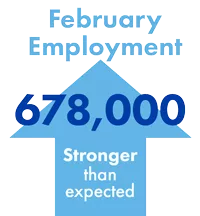March Economic Commentary: Strong February Employment Tempered by New Uncertainties

Chief Economist
Pohlad Companies
Just as the disruptive impact of the Omicron virus appears to be abating, another crisis has emerged. From an economic perspective, the invasion of Ukraine by Russia has created new uncertainties about the course of inflation, economic growth, and consequently, the pace of monetary tightening by the Fed. It is too soon to see the impact of the incursion on monthly economic reports, but there is little doubt that the jump in many commodity prices will soon be felt by U.S. consumers.
Inflation
The January report on inflation came in at 7.5% year over year. The core measure of inflation, which strips out food and energy costs, grew 6.0% year over year. So, it’s not just food and energy that are driving inflation. Real disposable income (the money left over after paying taxes and adjusted for inflation) is down 9.9% year over year. Personal savings are back down to levels last seen in mid-2019. Savings are being spent because wages are not keeping up with inflation. It is no wonder that consumer sentiment is at levels usually only seen during recessions.
Inflationary pressures are expected to ease as we move through the year, but the Ukrainian situation will keep inflation from falling as much as previously forecast. Increasing commodity prices will be one of the most obvious impacts of the war felt in the U.S. Additionally, higher commodity prices, especially from oil and agriculture products, are likely to produce a drag on economic activity.
The U.S. economy appears to be fairly well insulated from the war. Neither Russia nor the Ukraine are big export markets for the U.S. and our banks have little direct exposure to either country. The ISM manufacturing index for February indicated that manufacturing remains strong as inventories are being rebuilt and supply constraints are gradually easing. We have also seen a solid increase in construction spending both in residential and non-residential categories.

Employment
The employment report for February was stronger than expected and showed that non-farm payrolls gained 678,000 while the unemployment rate edged lower to 3.8%. Job growth was widespread. The actual number of unemployed people is down to 6.3 million compared to 5.7 million pre-pandemic. Average hourly earnings were, surprisingly, unchanged in February, which caused the year-over-year increase in hourly earnings to fall to 5.1% from a revised 5.5% yearly increase in January. It is too soon to say for sure, but the easing in hourly wage growth could be a signal that labor shortages are stabilizing.
Fed Funds
Chairman Powell, in his congressional testimony on March 2, made it clear that it will be appropriate to raise the target range for the Federal Funds rate at the upcoming March 16 meeting given that inflation is well above the Fed’s 2% target and that the labor market is strong. However, the Ukrainian war will likely cause the Fed to be nimble and proceed cautiously with their plans to tighten monetary policy, at least during the near term. Markets are pricing in a total of five 25-basis-point hikes in the Fed Funds rate this year. The Fed is also expected to start shrinking its balance sheet in the second half of the year.
The Fed’s challenge of trying to cool inflationary pressures without causing the economy to slow too much just became even more difficult. With oil prices closing at $115 per barrel on Friday, the Fed is aware that inflation is going to remain elevated for longer than they previously thought, but their policy actions must also account for the fact that high energy prices will likely slow economic growth. In order to engineer their hoped-for soft landing of the economy, they will need to have a degree of luck in ascertaining the proper degree of tightening to employ. Whereas COVID has been the wildcard in economic activity for the past two years, the new concern is Russia and the duration of their aggression.
Insights
Research to help you make knowledgeable investment decisions